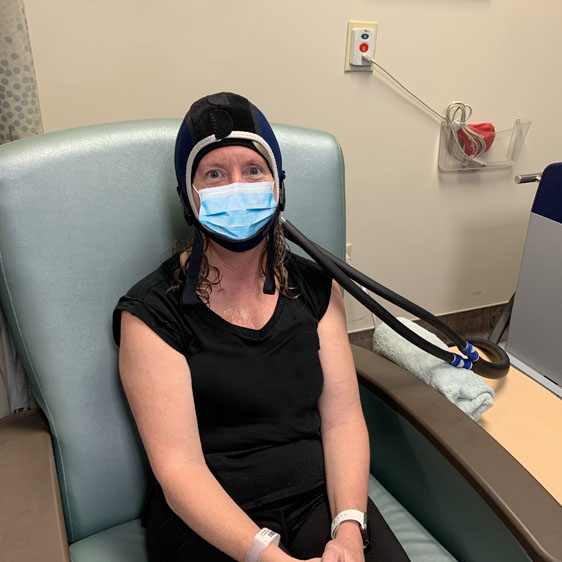Making Cancer Less Obvious
October 28, 2021

For 49-year-old Bluffton High School teacher Melanie Williams, discovering she had breast cancer during a routine mammogram this past July came as a life-changing blow.
Over the next several weeks, the mother of two would struggle to keep up with work, a busy home life and what seemed like a never-ending stream of doctor appointments and diagnostic tests. Her prognosis and how it would affect her two teenage children added to her anxiety.
The next phase of her cancer journey — enduring four rounds of chemotherapy — would create even more issues. While she was resigned to the trauma the powerful cancer drugs would cause her body, she dreaded one of its most conspicuous and devastating side effects — losing all of her shoulder-length hair.
Read More: Breast Cancer Myths
“You can wear a scarf or wig but everyone knows what that means — you have cancer,” Williams says. “I don’t want people looking at me with pity, especially as a teacher.”
Steeling herself for the embarrassment of being bald, she bought a couple of scarves. But prior to the start of her chemo she learned about a treatment that could save her from what she assumed was an inevitable outcome of the drug therapy.
An Option to Reduce Hair Loss
At one of her doctor appointments, a Beaufort Memorial breast care navigator told her about DigniCap, a scalp cooling treatment proven to reduce hair loss from chemotherapy.
Beaufort Memorial had just begun to offer the service after receiving numerous inquiries from cancer patients. Now available at the hospital’s Beaufort infusion center, the treatment takes place during chemotherapy sessions and can last from two and a half to six hours, depending on the medications being administered.
“By cooling the scalp, you decrease the blood flow to the area so less of the chemicals reach the hair cells,” says Dr. J. Eric Turner, medical oncologist with Beaufort Memorial Oncology Specialists, who sees patients in Beaufort at the Keyserling Cancer Center. “This process also decreases the reaction rate, causing normal cellular activity in the scalp to slow dramatically."
The idea of cooling the scalp during chemo dates back to the 1970s when some cancer patients began using bags of frozen vegetables or ice packs to try to stop the cancer drugs from “burning” their hair.
“Leave it to women to find a way,” said Melissa Bourestom, vice president of communications for medical technology company Dignitana, which produces DigniCap. “Throwing a bag of peas on your head was the most primitive form of scalp cooling.”
Technology Provides Consistent Scalp Cooling
 Some 20 years later, a Swedish oncology nurse intent on sparing cancer patients the emotional pain of losing their hair, teamed up with an engineer to develop a system that would produce more consistent, controllable results than frozen produce.
Some 20 years later, a Swedish oncology nurse intent on sparing cancer patients the emotional pain of losing their hair, teamed up with an engineer to develop a system that would produce more consistent, controllable results than frozen produce.
The original DigniCap system they created in 2009 consisted of a form-fitting silicone cap that is attached to a computerized cooling unit. Inside the cap are specially designed channels which allow coolant to be continuously circulated across all parts of the cap. Equipped with a sensor-controlled cooling element, the machine provides automatic monitoring of the temperature to ensure it stays just above freezing throughout the treatment.
Results of a clinical trial showed DigniCap prevented hair loss in 66.3 percent of patients receiving chemotherapy. In 2015, the medical device received clearance from the FDA. Two years later, the next generation DigniCap system was introduced. It uses a flexible, form-fitting cap powered by precise, thermo-electric cooling.
The treatment, available to cancer patients with solid tumors, is currently offered in more than 250 locations in the U.S. The infusion center at Beaufort Memorial is the only medical facility in Beaufort County providing the service.
To partake in the treatment, cancer patients have to purchase a DigniCap kit, which includes an inner cooling wrap that tightens around your head like a blood pressure cuff along with a neoprene cap that goes over the wrap to ensure constant contact to the scalp.
A Worthwhile Expense Covered by Some Insurance Plans
In addition to the $250 kit, DigniCap charges $300 per treatment. (Beaufort Memorial, which leases the cooling units for a nominal fee, simply facilitates the service and does not receive any of the payment.) Total cost for the treatment runs from $1,500 to $2,500 based on the number of cycles of chemotherapy a patient receives.
“Quite a few insurance companies cover the cost,” Bourestom says. “We offer an online hub to help patients file for reimbursements and can assist with the paperwork required for submission.”
After checking with her insurance company, Williams expects to be reimbursed 80% of the $1,450 she paid for the treatment.
“Even if the insurance hadn’t covered it, I would have done it anyway,” she says. “If it worked, it would be one less thing I would have to deal with.”
The treatment takes place at the infusion center and begins 30 minutes before the chemotherapy drugs are administered. Prior to putting on the cooling wrap and thermal cap, the patient’s hair is sprayed with water to improve thermal conductivity.
After the course of chemo is completed, the wrap and cap remain on the patient’s head for another 90 to 180 minutes, depending on the chemo regimen.
Read More: How to Do a Breast Self-Exam
“It’s cold, but you get used to it after the first half hour,” Williams says. “I bring a jacket and my own blanket to stay warm.”
Williams will have her final treatment later this month. So far, she has been impressed with the results. While she can tell her hair is a little thinner, she hasn’t had to wear the scarves she bought.
“I don’t look like I have cancer,” she says. “It’s helped keep me more positive, and my kids aren’t having to see me bald and think, ‘Oh my God, she has cancer.’”
Visit the DigniCap online patient support center to learn more and speak with an oncology nurse navigator about the possibility of adding DigniCap treatments to your chemotherapy plan.
Updated: November 2025

